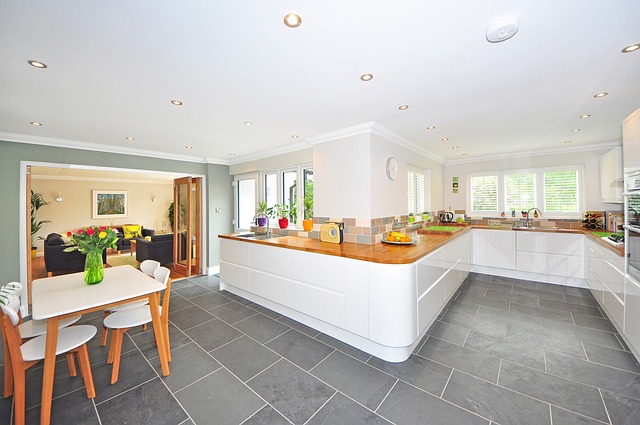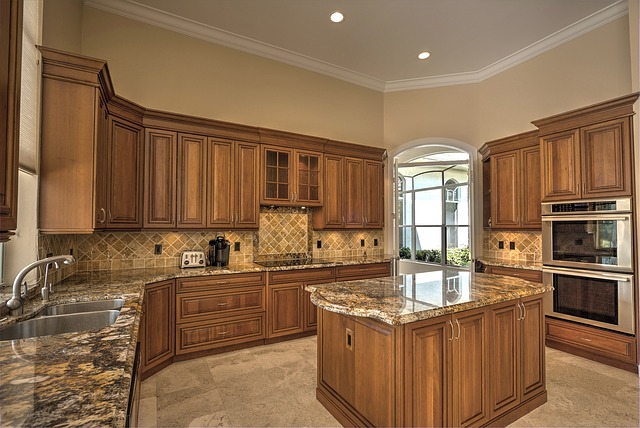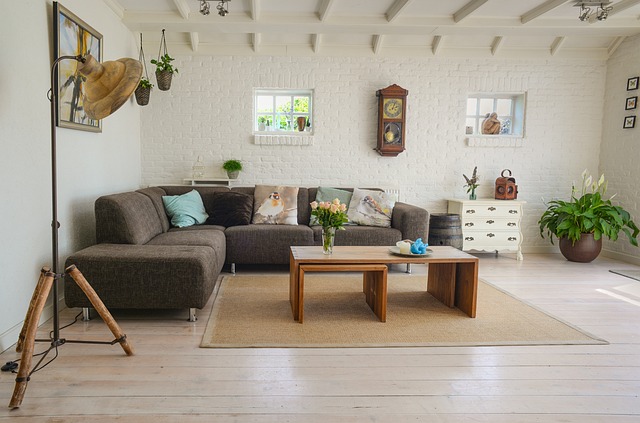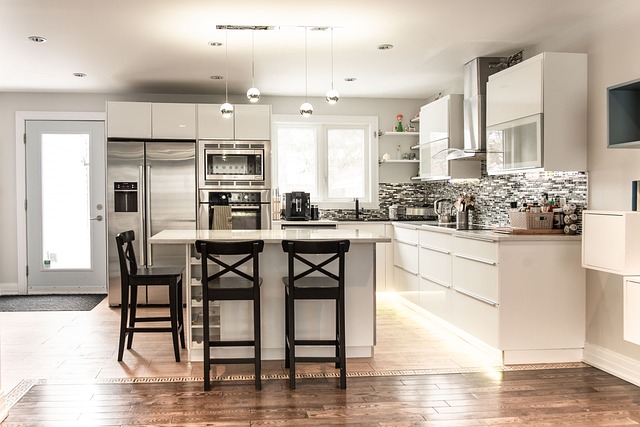When undertaking kitchen renovations, optimizing your lighting design is essential to enhance both functionality and aesthetics. Consider your kitchen's dimensions, natural light sources, and the time natural light is available to plan an effective lighting scheme. For small spaces, directional lighting can add depth, while larger kitchens may benefit from a combination of ambient, task, and accent lights. Utilize adjustable fixtures like track lights or pendant lamps to adapt to the sun's changing position for optimal natural light integration. Advanced lighting solutions, such as smart LED systems, offer energy efficiency and customizable settings, providing a seamless blend of ambient lighting, precise task lighting, and sophisticated accent lighting tailored to your kitchen's renovation. These systems can simulate natural light cycles and be controlled via voice or app, offering both environmental conservation and long-term cost savings. Additionally, motion sensors and occupancy detectors add a layer of convenience and safety. Overall, a thoughtfully designed lighting system during kitchen renovations not only elevates the space's visual appeal but also ensures it is functional and energy-efficient, making it a smart investment for comfort and practicality.
When embarking on kitchen renovations, lighting emerges as a pivotal element, not just for functionality but for setting an ambiance that mirrors the homeowner’s lifestyle and aesthetic. This article delves into the nuances of crafting the ideal lighting scheme within your kitchen space. From evaluating your kitchen’s dimensions and natural light sources to selecting fixtures that enhance both style and utility, each aspect is covered with a focus on ambient, task, and accent lighting’s interplay. Discover strategies for placing pendant lights and under-cabinet lighting to perfection, and explore the latest in smart and energy-efficient solutions that contribute to both savings and sophistication in modern kitchen renovations.
- Assessing Kitchen Dimensions and Natural Light Sources for Effective Lighting Design
- The Role of Ambient, Task, and Accent Lighting in Modern Kitchen Renovations
- Selecting the Right Lighting Fixtures to Complement Your Kitchen's Style and Functionality
- Strategic Placement of Pendant Lights and Under-Cabinet Illumination for Optimal Task Lighting
- Incorporating Smart and Energy-Efficient Lighting Solutions in Kitchen Renovations
Assessing Kitchen Dimensions and Natural Light Sources for Effective Lighting Design

When planning kitchen renovations, assessing your kitchen dimensions and natural light sources is crucial for an effective lighting design. Understanding the space’s layout allows for the strategic placement of lighting fixtures to enhance both functionality and aesthetics. Consider the size and shape of your kitchen; small spaces may benefit from directional lighting to create depth, while larger areas can accommodate a combination of ambient, task, and accent lighting for versatility. Take note of the natural light available through windows and doors during different times of the day. The position and size of these openings will influence the type and number of artificial lights needed to balance brightness and shadows, ensuring a harmonious transition between natural and artificial illumination.
Incorporating skylights or solar tubes can maximize daylighting, reducing the need for electric lighting during the day. For kitchen renovations, this not only conserves energy but also creates a healthier and more inviting environment. When the sun moves throughout the day, adjustable fixtures such as track lights or pendant lamps can be shifted to follow the natural light, maintaining optimal conditions for both culinary tasks and social gatherings. By considering these factors during kitchen renovations, homeowners can achieve a lighting design that not only serves its purpose but also contributes to the overall ambiance of the space.
The Role of Ambient, Task, and Accent Lighting in Modern Kitchen Renovations

kitchen renovations often prioritize lighting design to enhance both functionality and ambiance. Ambient lighting serves as the foundation, casting a warm, even glow that bathes the entire space in a soft light, creating a welcoming and cohesive atmosphere. This overall illumination sets the mood for the kitchen, allowing it to serve as a functional area while also contributing to its aesthetic appeal. Task lighting, on the other hand, is focused and directed where specific activities take place. Under-cabinet lights, for example, provide optimal brightness for food preparation or cooking, ensuring that kitchen tasks are performed with clarity and precision. Pendant lights over an island or sink are another example of task lighting, offering localized illumination exactly where it’s needed most. Accent lighting adds a touch of flair, highlighting architectural details or showcasing decorative elements within the kitchen. This can include toe-kick lights that subtly outline the perimeter of the kitchen or spotlights that draw attention to a stunning backsplash or a piece of art. When thoughtfully integrated with ambient and task lighting, accent lighting not only adds character but also contributes to a safe and efficient environment in modern kitchen renovations. The synergy between these three types of lighting creates a harmonious and functional space that can adapt to various activities and moods, making kitchen renovations not just an upgrade but a transformation in the heart of the home.
Selecting the Right Lighting Fixtures to Complement Your Kitchen's Style and Functionality

When undertaking kitchen renovations, selecting the right lighting fixtures is pivotal to achieving both the desired ambiance and functionality. The kitchen is not just a place for culinary activities but also a space for social gatherings and family interactions. A well-planned lighting scheme can enhance this versatility by highlighting architectural details and creating a warm, inviting atmosphere. Consider the style of your kitchen—modern, traditional, or something in between—and choose fixtures that complement and accentuate these elements. For instance, sleek, minimalist pendant lights above an island can serve as a focal point in a contemporary space, while chandeliers with a classic design might be more suited to a traditionally styled kitchen.
In addition to style, the task lighting must be practical. Under-cabinet lighting is essential for precise food preparation and cooking tasks, reducing eye strain and improving efficiency. Recessed ceiling lights provide general illumination, while track lighting or directional spotlights can be directed over areas where fine details of food presentation or work require clear visibility. When planning kitchen renovations, think about the balance between ambient, task, and accent lighting to create a layered effect that is both aesthetically pleasing and functional. The right combination of lighting fixtures not only enhances the beauty of your kitchen but also makes it a safer and more pleasant space to use throughout the day.
Strategic Placement of Pendant Lights and Under-Cabinet Illumination for Optimal Task Lighting

When considering kitchen renovations, the strategic placement of lighting fixtures plays a pivotal role in enhancing both functionality and ambiance. Pendant lights, with their versatile design and adjustable positioning, can be positioned over an island or sink to provide targeted illumination for tasks such as food preparation or dining. Their directional light casts shadows where they are needed least, allowing for clear visibility while imparting a warm and inviting atmosphere. Additionally, under-cabinet lighting is an essential element for optimal task lighting. Installed either as recessed lighting or with standalone fixtures, this type of lighting directly addresses the shadows that upper cabinets can cast on countertops. By eliminating dark spots, it ensures that kitchen tasks are performed with precision and ease. The combination of these two lighting strategies not only elevates the aesthetic appeal of the space but also makes everyday activities in the kitchen more efficient and enjoyable, thereby making kitchen renovations a worthwhile investment for homeowners looking to enhance both the utility and charm of their kitchens.
Incorporating Smart and Energy-Efficient Lighting Solutions in Kitchen Renovations

Kitchen renovations present an opportune moment to integrate smart and energy-efficient lighting solutions that enhance both functionality and ambiance. Advancements in LED technology have made it possible to create warm, inviting spaces while significantly reducing energy consumption. When planning kitchen renovations, homeowners should consider the benefits of smart lighting systems, which offer adjustable brightness, color temperature settings, and voice or app control for a personalized experience. These systems can be programmed to mimic natural light patterns throughout the day, ensuring optimal conditions for both meal preparation and dining experiences. Additionally, incorporating energy-efficient LED fixtures not only contributes to environmental sustainability but also leads to cost savings over time. By selecting from a variety of sleek, modern designs, homeowners can maintain the aesthetic appeal of their kitchen while reaping the practical advantages of smart lighting. The integration of motion sensors and occupancy detectors further elevates the functionality of these systems, providing safety and convenience by illuminating spaces as needed without the need for manual switching. In doing so, kitchen renovations become not just an update to a room’s appearance but a thoughtful investment in both comfort and efficiency.
Effective kitchen lighting design is pivotal for both visual appeal and functional tasks, ensuring that kitchen renovations are both stylish and user-friendly. By carefully considering dimensions, natural light sources, and the integration of ambient, task, and accent lighting, homeowners can transform their kitchens into versatile spaces that cater to culinary endeavors and social gatherings alike. The judicious selection of lighting fixtures that align with a kitchen’s design ethos, combined with strategic placement options like pendant lights and under-cabinet lighting, elevates the overall ambiance while enhancing performance. Moreover, embracing smart and energy-efficient solutions in kitchen renovations not only promotes sustainability but also offers contemporary convenience. In conclusion, a well-planned lighting strategy is essential for any successful kitchen renovation, making it a key consideration for those looking to update their space with both flair and functionality in mind.
